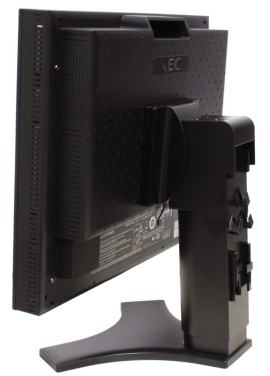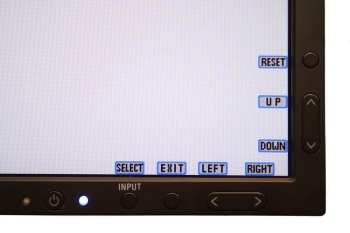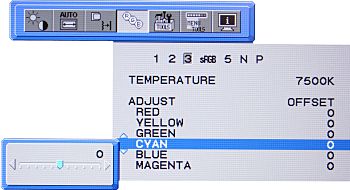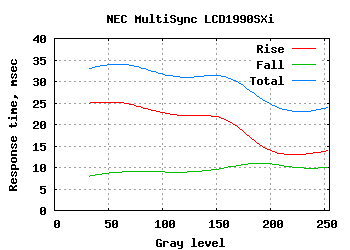LCD MONITOR REVIEW NEC MULTISYNC LCD1990SXI 19 INCH
![]()
|
|
 |
||||||||||||
| Posted:2006-07-08 By lcd monitor Number of View:29613 |
|||||||||||||
By :lcd monitor Posted:2006-07-08
NEC MultiSync LCD1990SXiNEC’s 60th and 70th series of lcd monitors (e.g. LCD1960NXi and LCD1970GX) are officially positioned as lcd monitors for home and office use whereas the 80th and 90th series are touted as serious products for work with color and CAD/CAM applications. These are manufactured exclusively on S-IPS and PVA matrixes, the former having the suffix “i” in the model name (thus, the reviewed LCD1990SXi employs an S-IPS matrix manufactured by LG.Philips LCD whereas the LCD1980SX has a PVA matrix from Samsung).
The lcd monitor has a solemn-looking black case (a light-color version is available, though) without any decorations which are of course unacceptable in a professional model. The overall design resembles NEC’s older models. In the 70th series the designers tried to smooth out the angles of the case to make it more appealing for a home user, but the 90th series has it the old straight-lined way. It’s only the base that has become a little more elegant – it has a rectangular shape in the LCD1980SXi.
The base allows doing just everything you can imagine with the screen: change its tilt, pivot it into the portrait mode, adjust its height, and rotate the screen around its vertical axis
The LCD1990SXi has three inputs in total: a digital DVI-I, an analog D-Sub, and a universal DVI-I. You can attach both digital and analog (via an adapter) sources to the latter. A DC out connector can be seen on the left of the video connectors. It is a power output for speakers that have to be purchased optionally.
The professional positioning of the 1990SXi model didn’t allow the NEC engineers to use the frivolous joystick (which is also inclined to malfunctioning often), but they obviously didn’t want to introduce any radical changes into the way the lcd monitor is controlled. So, they came up with a curious solution. They removed most of the meaningful labels from the buttons, and the labels now appear next to the buttons right on the screen when you enter the menu. This solution isn’t blameless in my eyes. Yes, it is innovative, but they should have labeled the button you enter the menu with. And secondly, it’s easier to read text on buttons rather than on the screen, while the functionality of the lcd monitor’s controls isn’t as large as to call for context-sensitive labels. A minor plus of this labeling system is that the text is of course visible in full darkness, but it’s generally not recommended to work without external lighting, and you also have to fumble for the buttons by touch alone. So, I personally prefer the LED-based highlighting like in the ASUS PW191 (not necessarily with touch-sensitive buttons).
The menu hasn’t changed much externally, just a face-lift over the 70-th series, but the selection of options it provides has been greatly extended. First, the lcd monitor is equipped with an external light sensor and you can enable automatic adjustment of contrast and brightness. When the Auto Brightness feature is turned on, the lcd monitor’s brightness is adjusted whenever the lighting in your room changes. This adjustment is performed smoothly rather than in a jump – you can even enter the lcd monitor’s menu at this moment and see the Brightness slider moving slowly. This auto-brightness feature is implemented perfectly and is not at all annoying (I personally dislike electronics that’s deciding something for me – it often fails to do things right, you know). The top and bottom brightness limits are specified by the user: you should turn on all the lights in your room, enter the menu and put the Brightness setting into the necessary position. The minimum limit is set up in the same way. From this point on, the lcd monitor will only be varying its brightness within these two threshold values when in Auto Brightness mode. What’s more, another mode for automatic brightness adjustment is available. It doesn’t use the light sensor – the lcd monitor adjusts brightness by analyzing the current image. I think this mode is less interesting just because a lcd monitor is supposed to display images as they are, without trying to make them look better. The automatic contrast adjustment feature works with the analog input only and, quoting the manual, “Adjusts the image displayed for non-standard video inputs”. I didn’t see any visible effect from this feature in my tests – our testbed is obviously equipped with a standard video output :). This Auto-Brightness feature has one more use, by the way. The lcd monitor can “go to sleep” on its own when it gets dark in the room. The light intensity threshold for the lcd monitor to turn off is specified by the user.
The color reproduction setup options have been extended, too. Color temperature can be set up by six coordinates (save for the sRGB, Native and Programmable modes) – this feature is customary for professional lcd monitors, but rare in consumer products. Two programs can be used with the MultiSync LCD1990SXi: NaviSet (allows changing the lcd monitor’s settings from Windows) and GammaComp (per-point gamma curves correction; this feature might be called “hardware calibration” if it were not for one hitch – GammaComp doesn’t support calibrators directly, so it takes some time and ingenuity to perform a real hardware calibration). The LCD1990SXi uses 12-bit internal color representation, but has an ordinary 8-bit matrix. The enhanced color precision is needed for a more accurate processing of the image when adjusting it for the specified contrast, color temperature and gamma curve and allows avoiding such artifacts as striped gradients. In other words, the lcd monitor receives 8-bit data from the computer, translates them into 12-bit format for processing, processes and translates back into 8-bit form and finally sends them to the matrix. The lcd monitor’s brightness and contrast are set at 100% and 50% respectively by default. To achieve 100-nit brightness of white I selected 51.4% brightness and 42.1% contrast (the numbers are not rounded off in the lcd monitor’s menu, although there’s not much practical sense in such precision).
The gamma curves are very neat except for the small bend in the top right. This small defect can be observed on other NEC lcd monitors at the default settings, but it doesn’t vanish here when you lower the contrast. This defect isn’t too serious, though. You will hardly notice it at work.
The quality of color temperature setup can be evaluated from two standpoints: 1) how close the real temperature is to the name of the corresponding menu setting/mode and 2) how far the temperatures of different levels of gray differ at the same menu setting. The first parameter is not critical, especially if the deflection from the nominal value isn’t too big and the number of available settings/modes is large enough for you to choose exactly what you need. As you can see, the real temperature is a little higher than the nominal value in each mode the LCD1990SXi offers. The second parameter is more important because if there is a great difference between the temperatures of different levels of gray (it amounts to thousands degrees in some lcd monitors!), an ordinary grayscale gradient looks toned or colored in some spots. The worst case is when the temperature of white is much lower than that of light-gray – this difference can be easily caught by the eye. And from this point of view, the LCD1990SXi is blameless. It’s only the temperature of dark tones that differs much from white, but this difference is not readily perceived by the eye whereas the temperatures of white and light-gray are very close.
The lcd monitor has an S-IPS matrix without response time compensation. A full response time of 18 milliseconds is declared (on a black-white-black transition), but it is in fact closer to 25 milliseconds. Generally speaking, the 16ms S-IPS matrixes installed in 20” lcd monitors are noticeably faster than their 19” 25ms counterparts, but here you can’t see any big difference from 25ms matrixes. The lcd monitor is rather fast, however. Although the full response is nearly 35 milliseconds, its rise time nearly equals the fall time whereas in TN+Film matrixes with a full response of 35 milliseconds the fall time is only 2-4 milliseconds. As a result, S-IPS matrixes look subjectively faster if you compare RTC-less lcd monitors on S-IPS and TN+Film (S-IPS technology cannot compete with RTC-enabled lcd monitors, of course).
The lcd monitor’s contrast ratio is average, which is no news since S-IPS matrixes have never had a really high contrast. Moreover, a violet shimmer, characteristic of this matrix manufacturing technology, can be seen on a black background if you’re looking at the screen from a side, especially along the diagonal of the screen. This effect isn’t conspicuous and most users just don’t care about it, considering the fact that S-IPS matrixes are unrivalled in terms of viewing angles and color distortions on other LCD matrix types become apparent much more readily than the mentioned violet. So, the MultiSync LCD1990SXi is a very high-quality work-oriented lcd monitor (but it is also rather expensive at about $700). It comes in a handy and workplace-suitable case. The portrait mode and screen height adjustment are available. The lcd monitor also offers rich setup opportunities and boasts a good reproduction of colors. All this makes it an excellent choice as a basic model for work with color and in CAD/CAM applications (after all, not all people can afford a professional lcd monitor from the SpectraView or ColorEdge series). You may want to buy this lcd monitor for home if you need an accurate color reproduction and options to fine-tune it. Otherwise you should be informed of the fact that the same money can buy you, say, a 20” NEC MultiSync 20WGX2 which has a larger screen and a faster matrix.
we would be happy to answer for your question . if you have suggestion or comment
regarding this review our support would be glad to help just join our forum and ask u will get the best answer
to discuss check our forum section :-) RATE THIS REVIEW | |||||||||||||
![]()

lcd monitor review NEC MultiSync LCD1990SXi 19 inch
lcd monitor review NEC MultiSync LCD1990SXi 19 inch


7600gt review
7600gt is the middle card range.
We already benchmarked this video card and found that ...

 geforce 8800gtx and 8800gts
geforce 8800gtx and 8800gts  Xtreview software download Section
Xtreview software download Section  AMD TURION 64 X2 REVIEW
AMD TURION 64 X2 REVIEW  INTEL PENTIUM D 920 , INTEL PENTIUM D 930
INTEL PENTIUM D 920 , INTEL PENTIUM D 930  6800XT REVIEW
6800XT REVIEW  computer hardware REVIEW
computer hardware REVIEW  INTEL CONROE CORE DUO 2 REVIEW VS AMD AM2
INTEL CONROE CORE DUO 2 REVIEW VS AMD AM2  INTEL PENTIUM D 805 INTEL D805
INTEL PENTIUM D 805 INTEL D805  Free desktop wallpaper
Free desktop wallpaper  online fighting game
online fighting game  Xtreview price comparison center
Xtreview price comparison center 

- The new version of GPU-Z finally kills the belief in the miracle of Vega transformation
- The motherboard manufacturer confirms the characteristics of the processors Coffee Lake
- We are looking for copper coolers on NVIDIA Volta computing accelerators
- Unofficially about Intels plans to release 300-series chipset
- The Japanese representation of AMD offered monetary compensation to the first buyers of Ryzen Threadripper
- This year will not be released more than 45 million motherboards
- TSMC denies the presentation of charges from the antimonopoly authorities
- Radeon RX Vega 64 at frequencies 1802-1000 MHz updated the record GPUPI 1B
- AMD itself would like to believe that mobile processors Ryzen have already been released
- AMD Vega 20 will find application in accelerating computations
- Pre-orders for new iPhone start next week
- Radeon RX Vega 57, 58 and 59: the wonders of transformation
- ASML starts commercial delivery of EUV-scanners
- The older Skylake processors with a free multiplier are removed from production
- Meizu will release Android-smartphone based on Helio P40
- AMD Bristol Ridge processors are also available in American retail
- The fate of Toshiba Memory can be solved to the next environment
- duo GeForce GTX 1080 Ti in GPUPI 1B at frequencies of 2480-10320 MHz
- New Kentsfield overclocking record up to 5204 MHz
- Lenovo released Android-smartphone K8



computer news computer parts review Old Forum Downloads New Forum Login Join Articles terms Hardware blog Sitemap Get Freebies











